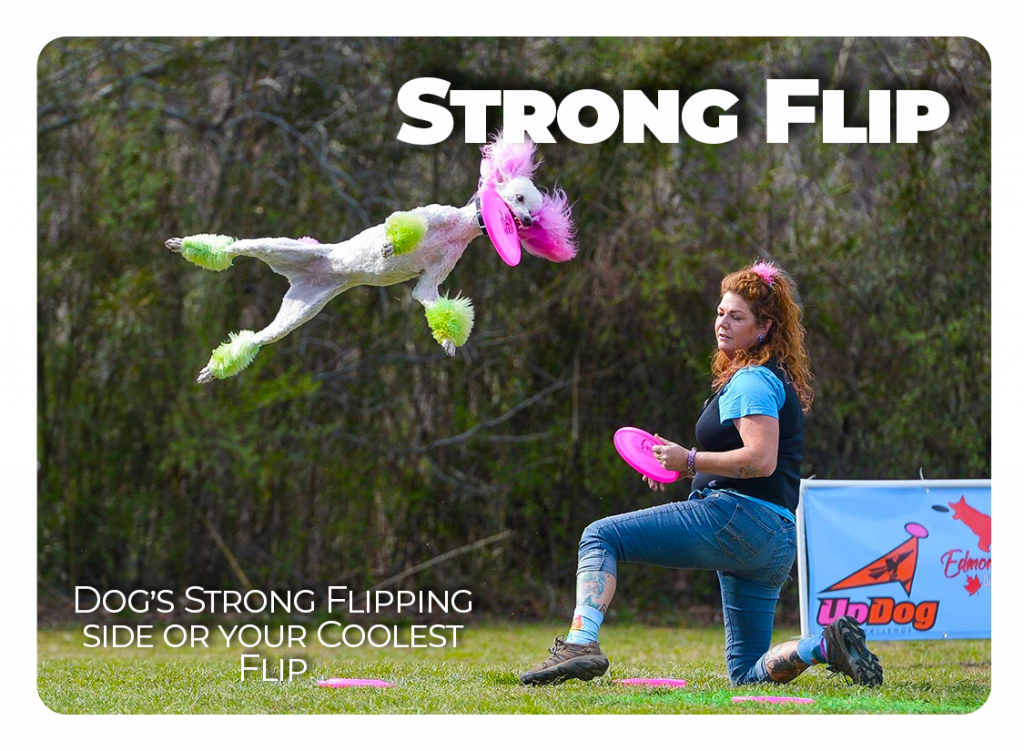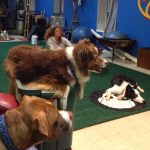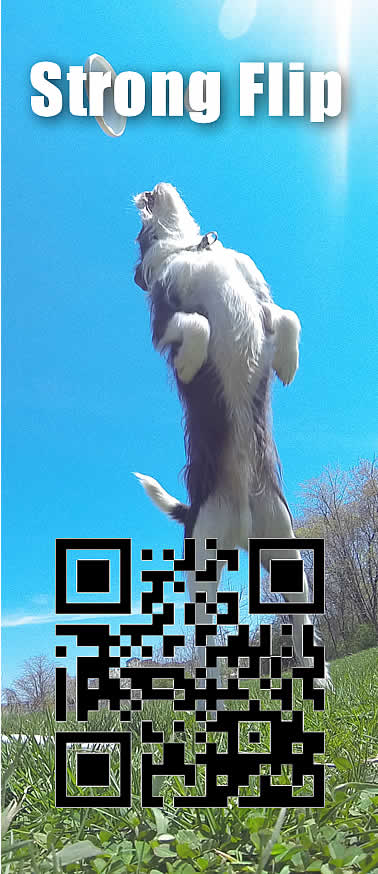
Strong Flip
Dog flips for Disc to Their Strong Side

dog flips for a disc to their strong side – didn’t know a dog had a strong side? read on… know which side we’re talking about? Read on…
This Skill has 5 Keys:
- Placement
- angle of disc
- balanced landings
- landing on front feet is OK
- repetition is a killer
Placement is Key
flipping is more artform than science – the dog flips because that’s the best or only way to get it – your job is to find that spot and hit it
If you put it above your dog’s head the resultant flip is likely to be more vertical. Not all dogs can do loops. The further out away from the dog’s head you go the more the dog spins or helicopters. If you are learning the skill, it is best to start from the outside and work to the center, and remember that flips happen behind your dog.
When your dog is flipping for a disc, as they leave the ground they are pretty much standing on their hind legs, as Hops is in the image above. Your throw must be higher than your dog is tall at the moment of takeoff. This means that flip tosses, even for small dogs are chest high at a minimum. Be sure to take that into effect.
Safety in Balance
a safe landing is one where the dog lands in a position of balance or with the momentum to move smoothly into the next trick…
Ideally the dog lands a flip in perfect balance. If you do a good job of precise, consistent disc placement (to the right spot Spot is a “go to a place”, or “go to a mat” behavior. This means that the dog seeks out and performs a duration behavior on a spot of the handler’s choosing. A... More!) with your dog, odds are your dog is landing fairly balanced. The dog should be able to move in any direction at the moment the flip is complete. Eliminate any disc placement or flipping styles that create unbalanced, unpredictable, or haphazard landings.
Spot is a “go to a place”, or “go to a mat” behavior. This means that the dog seeks out and performs a duration behavior on a spot of the handler’s choosing. A... More!) with your dog, odds are your dog is landing fairly balanced. The dog should be able to move in any direction at the moment the flip is complete. Eliminate any disc placement or flipping styles that create unbalanced, unpredictable, or haphazard landings.
Smooth, fluid movement is also a good indication of the safety of a landing.
Front Feet First is OK
the front end funnels and channels landings into the rear end – this should be flowing and fluid – stiff handstands, tweaks and clunks on landing are not cool
There is a conventional wisdom that seems to hang around the disc dog world that front footed landings are not ok. You will never see your dog jump off of something higher than a couple of feet and land on all fours or their rear feet first. It’s not how they work.
The front feet navigate the landings. They buy time for the rest of the body to prepare for the momentum changes and balance adjustments.It is OK if your dog lands front feet first. You want to avoid clunking, straining, and other kinds of unbalanced, un-fluid landings.
Repetition is a Killer
if I punched you in your shoulder as hard as I can, it would bruise and hurt for a while. but if I poke your shoulder once every second for a year with my finger, I destroy your shoulder…
Repetitive stress is the real killer in all dog sports. It’s not the big, spectacular crashes, but that nagging, never ending right hand turn, or the gazillion flip landings, or the early developmental exploitation of a new vault by an excited handler.

Don’t do a bunch of flips in a row for no reason. If your dog is tired, stop playing. If you’re finding yourself stopping and doing flips for people in the park and stuff like that? You’re probably doing too many.




Responses